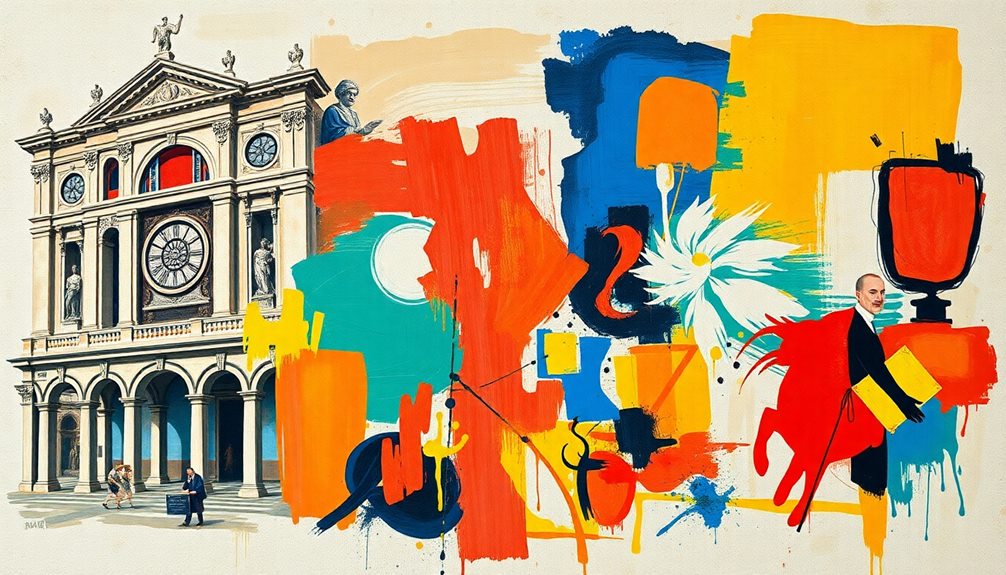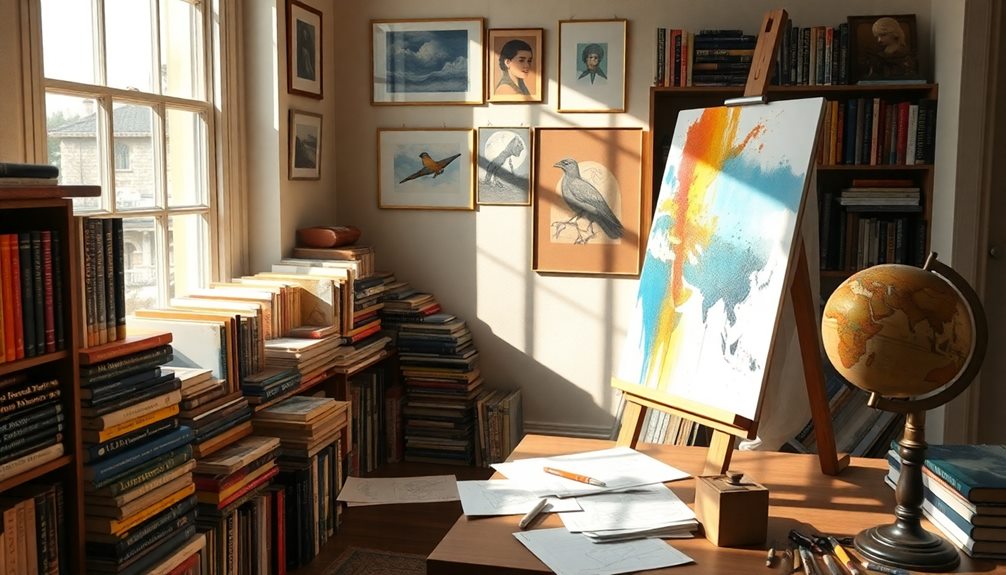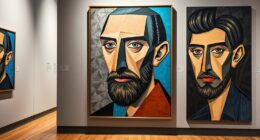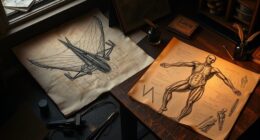The evolution of artistic styles showcases how human creativity has changed over time. You'll notice shifts from the realism of the Renaissance to the emotional depth of Romanticism, and then onto the light-infused Impressionism. As styles progressed, movements like Cubism introduced abstraction, breaking traditional forms. Contemporary art brings technology and social themes into play, pushing boundaries further. Each movement reflects its cultural context, influencing how we perceive art today. Dive deeper, and you'll uncover fascinating connections and insights about artists and their visions throughout history.
Key Takeaways
- Major art movements such as Renaissance, Impressionism, and Cubism have significantly influenced the evolution of artistic expression throughout history.
- Impressionism shifted focus to personal perception, light, and color, moving away from traditional techniques and emphasizing quick brushstrokes.
- The 20th century introduced abstraction and experimentation, with movements like Cubism redefined representation through fragmented geometric forms.
- Contemporary art incorporates technology and addresses themes such as identity, globalization, and social commentary, encouraging audience participation.
- Understanding historical context enhances appreciation for artistic movements and the emotional responses they evoke in viewers.
Introduction
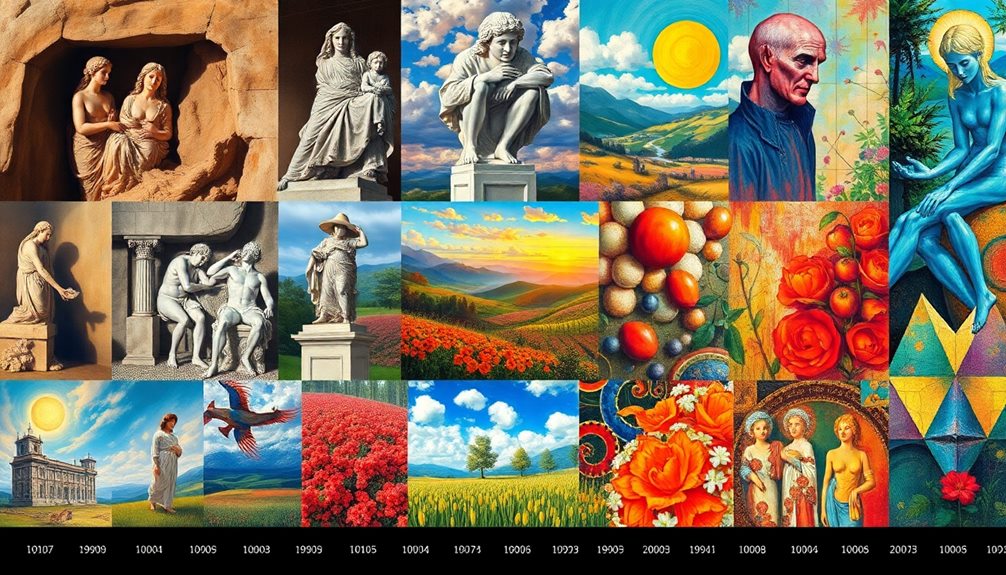
Artistic styles have always evolved, reflecting the dynamic interplay of culture, society, and politics over time. As you explore the evolution of Western Art, you'll notice that major art movements, such as the Renaissance and Baroque, played pivotal roles in shaping artistic expression.
Renaissance artists shifted focus from religious themes to individualistic perspectives, emphasizing naturalism and emotional depth. This laid the groundwork for the modern art movement, which emerged in the late 19th century.
You'll find that the Impressionist movement, a significant departure from traditional techniques, prioritized individual perception and the fleeting qualities of light and color. This marked a dramatic shift towards abstraction and experimentation that continued into the 20th century, leading to styles like Cubism.
Now, contemporary art, spanning from the late 20th century to today, showcases an even broader range of artistic styles and mediums. It often incorporates technology and addresses complex themes like identity and globalization.
Each art movement and style influences the next, creating a rich tapestry of ongoing dialogues between historical and contemporary practices. Understanding these transitions helps you appreciate the continuous evolution of artistic expression.
Key Concepts and Definitions
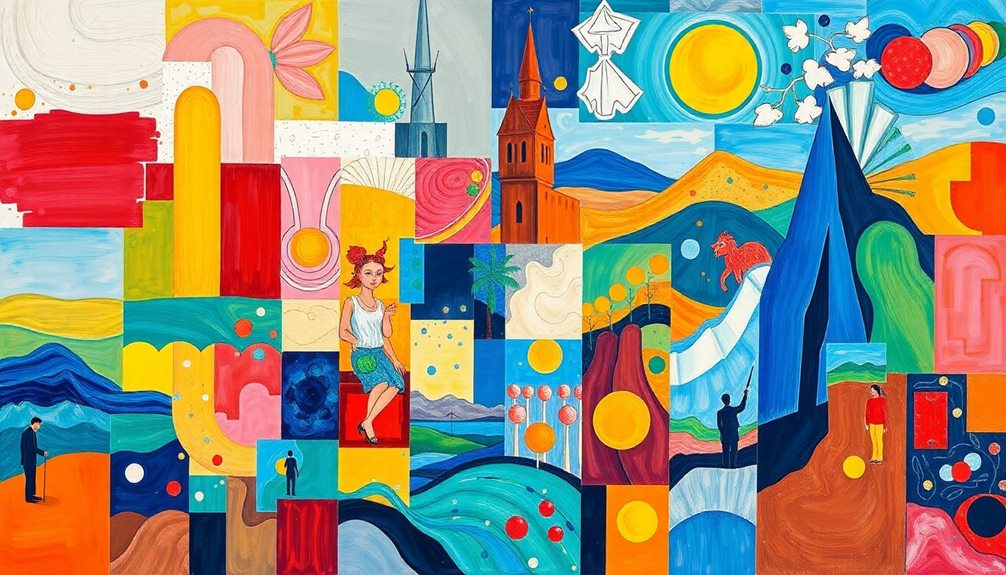
Throughout history, various key concepts and definitions have emerged to shape the understanding of art and its evolution. Art movements like Impressionism and Post-Impressionism highlighted the importance of personal perspective and emotional expression, paving the way for later styles. In this context, the importance of art theory is fundamental as it provides a foundational understanding that informs artistic practice.
You'll see how Post-Impressionism diverged from the more observational approach of Impressionism, as artists like Vincent van Gogh emphasized their unique techniques and feelings.
Moving into the 20th century, Modern art movements such as Cubism and Dadaism challenged traditional representations, embracing abstraction and absurdity in response to contemporary society. This shift set the stage for Abstract Expressionism, which focused on spontaneous and emotional expression.
Contemporary art, emerging from the 1970s onward, reflects globalization and technological integration, encompassing diverse styles like digital art and installation art. Within this realm, Minimalism stands out by prioritizing simplicity, while Conceptual Art emphasizes ideas over aesthetics.
These concepts encourage you to engage with the underlying messages rather than just the visual appeal. Understanding these key definitions lays the groundwork for appreciating the complexities and innovations in the ever-evolving landscape of artistic expression.
Art Movement Characteristics Overview
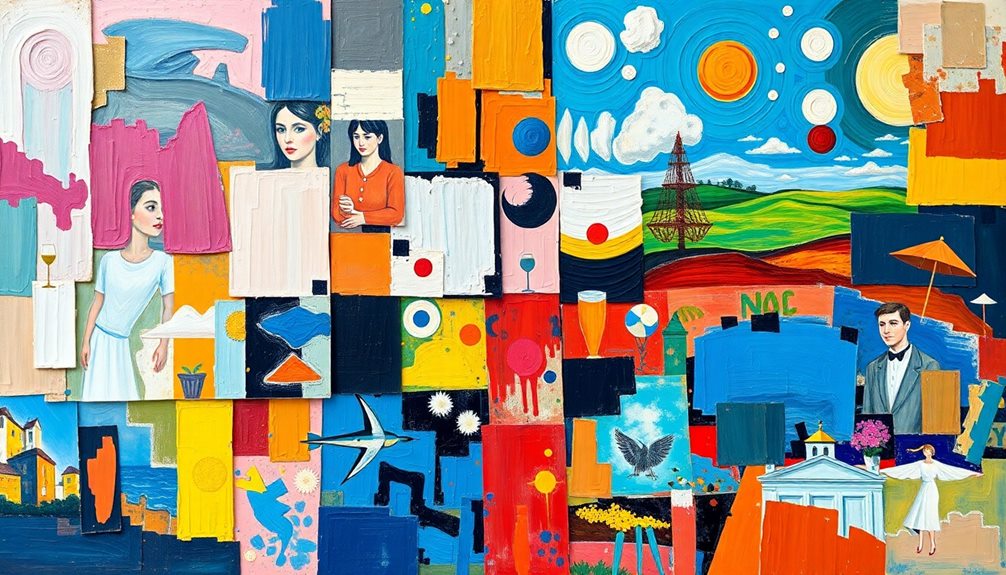
Understanding the characteristics of various art movements provides insight into how artistic expression has evolved over time. Each movement reflects different themes and techniques that artists have embraced.
For instance, Neoclassicism emphasized harmony and simplicity, focusing on classical ideals, while Romanticism celebrated emotional expression and individualism through passionate imagery.
As you explore Impressionism, you'll notice the quick brushstrokes and emphasis on light, capturing fleeting moments, as seen in Claude Monet's works. This movement paved the way for Cubism, where artists like Pablo Picasso and Georges Braque broke subjects into geometric forms, presenting multiple viewpoints simultaneously, redefining representation in the visual arts.
Moving into the contemporary art period, Pop Art emerged, challenging traditional notions of fine art. By incorporating commercial imagery, artists like Andy Warhol critiqued consumer culture, merging high and low art.
Each of these art movement characteristics reveals the shifting priorities and techniques throughout history. From the emotional depth of Romanticism to the playful irony of Pop Art, understanding these movements enriches your appreciation of the diverse landscape of artistic expression.
Notable Artists and Works
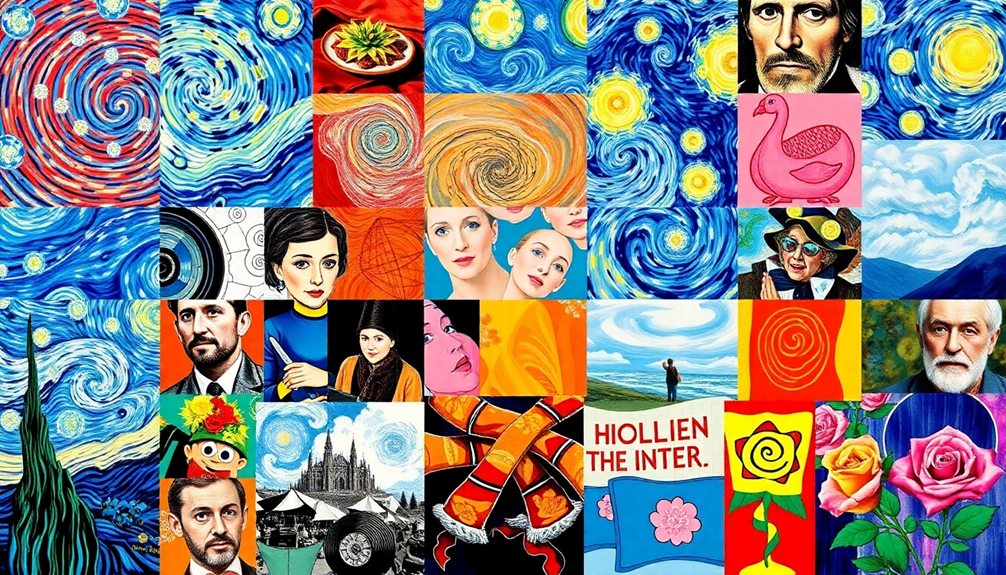
Since the Renaissance, artists have left an indelible mark on the art world with their innovative works and unique styles. Notable artists like Leonardo da Vinci exemplify this legacy through masterpieces such as the *Mona Lisa* and *The Last Supper*, which showcase realism and human emotion via techniques like sfumato and chiaroscuro.
Moving into the Post-Impressionism art period, Vincent van Gogh's expressive use of color and brushwork shines in works of art like *Starry Night* and *Sunflowers*.
Pablo Picasso took a bold step forward with Cubism, transforming traditional perspectives in pieces like *Les Demoiselles d'Avignon*. His approach fragmented forms and challenged viewers to see art differently.
Frida Kahlo's deeply personal self-portraits, including *The Two Fridas*, explore identity and cultural heritage, adding a unique voice to the narrative of art forms.
In the realm of Pop Art, Andy Warhol pushed boundaries with his iconic *Campbell's Soup Cans*, blurring lines between commercialism and artistic expression.
Together, these artists and their works of art illustrate the evolution of styles, reflecting the diverse tapestry of human experience.
Tips and Best Practices

As you explore the evolution of artistic styles, adopting certain tips and best practices can enhance your understanding and appreciation. Start by studying major art movements chronologically. This approach allows you to see how each period influenced the next, focusing on key characteristics and notable artists associated with each style.
Additionally, consider how elements like music therapy integration can inspire creativity and emotional expression as you delve into the artistic process.
Familiarize yourself with the historical context and cultural factors that shaped these artistic expressions. Understanding the social and political climate of the time can deepen your insight into the motivations behind various artworks.
Next, explore the techniques and materials used by artists. For instance, consider how oil paint during the Renaissance offered richer color palettes or how en-plein-air painting in Impressionism captured natural light in a unique way. Next, explore the techniques and materials used by artists. For instance, consider how oil paint during the Renaissance offered richer color palettes or how en-plein-air painting in Impressionism captured natural light in a unique way. Additionally, the development of color theory in formalist art pushed boundaries, emphasizing the relationship between hues and their emotional or compositional impact. This approach allowed artists to innovate beyond representational art, using color as a primary tool for expression and meaning. Moreover, advancements in synthetic pigments provided a broader range of tones, further shaping artistic possibilities.
Engage with primary sources like art critiques and manifestos from artists to grasp their intentions and philosophies.
Audience Engagement and Feedback

Art has transformed dramatically in how it engages with audiences, shifting from passive observation to active participation. In contemporary artistic styles, audience engagement is at the forefront, inviting you to become part of the experience. No longer just spectators, you're encouraged to interact, share, and even co-create.
Feedback mechanisms have evolved, especially with the rise of social media, allowing artists to receive immediate responses and critiques from a global audience. This fosters a dynamic dialogue between creators and viewers, enhancing the creative process. Many artists now embrace participatory art, where your input can shape the artwork, blurring the lines between artist and audience.
Moreover, community involvement is crucial in contemporary art practices. Artists often reflect social issues through collaborative projects, encouraging public discourse and fostering a sense of belonging.
Data analytics tools also play a role, helping artists and galleries assess audience preferences, which in turn tailors exhibitions to enhance viewer satisfaction.
In this new landscape, your voice matters. By engaging with art actively, you contribute to its evolution and relevance, making the experience richer and more meaningful for everyone involved.
Cultural Context Impacts Interpretation
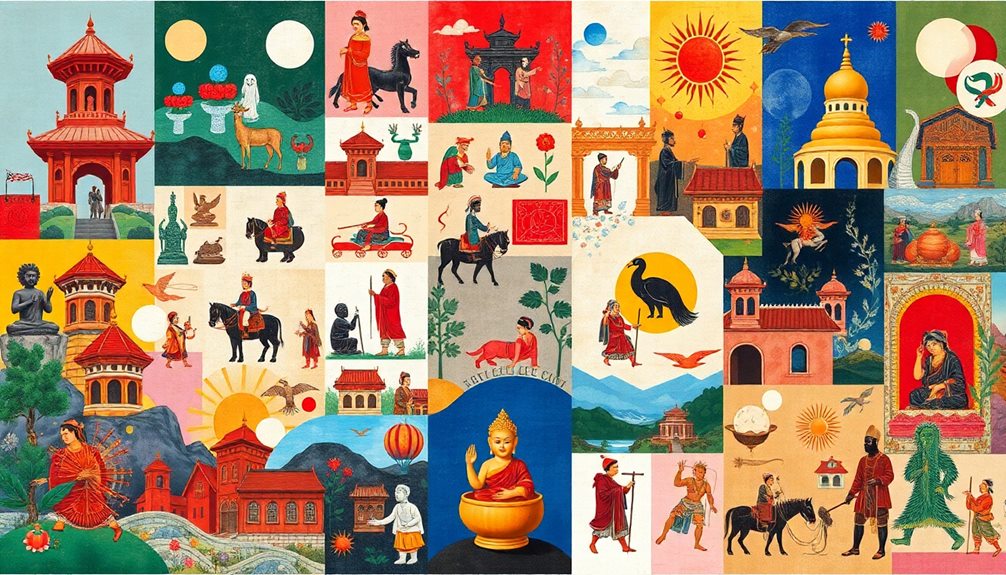
Cultural context deeply influences how you interpret artistic styles, shaping your understanding and emotional response to the work. Each movement in art, from Impressionism to Dadaism, emerges as a reflection of the societal backdrop of its time.
For instance, Impressionism arose in the late 19th century, capturing the fleeting effects of light and color amidst the rapid industrialization and urbanization of contemporary life. This shift in focus mirrors a broader cultural change, moving away from the rigid themes of past eras.
Similarly, the Romantic painters embraced emotional depth, expressing the human experience against the backdrop of societal upheaval. They used symbolism to convey deeper emotional truths, a response to the tumultuous changes occurring around them.
Dadaism, born out of World War I, directly challenged traditional values, embodying the disillusionment felt by many during that chaotic period.
Understanding these connections helps you appreciate how cultural context shapes not only the creation of art but also its interpretation. By recognizing the influences behind each movement, you gain insight into the emotional and societal currents that guide artistic expression throughout history.
Additional Resources
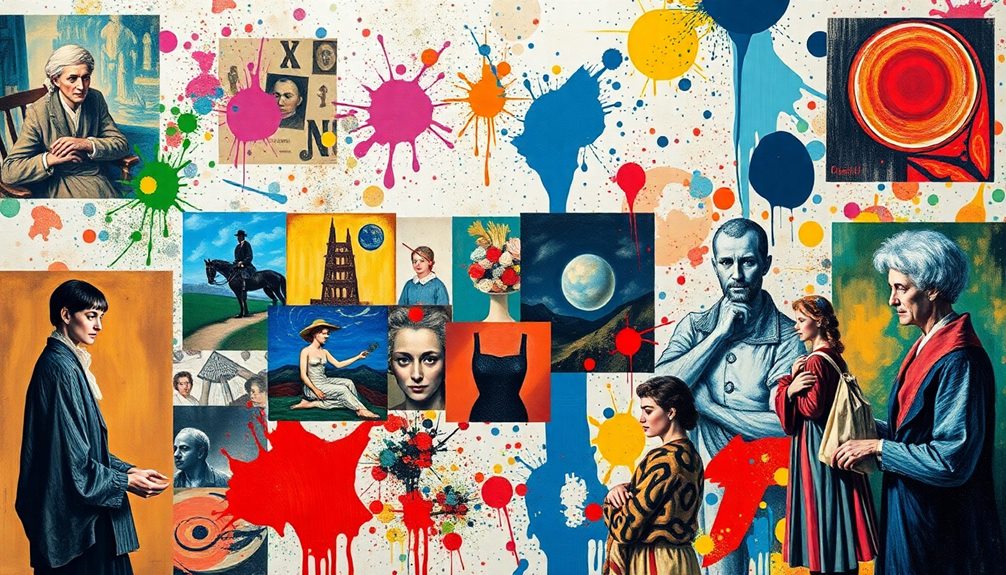
Understanding the evolution of artistic styles can be enhanced by exploring additional resources that provide deeper insights into the movements and techniques discussed. You can start by examining an art history timeline that outlines significant shifts, such as the transition from Medieval Art to the Renaissance.
This journey reveals how themes like humanism and nature influenced art from this period, including the revolutionary use of oil paint, which allowed for more vibrant representations.
Delve into Impressionism next, where you'll discover how artists emphasized light and color through rapid brushstrokes, challenging traditional conventions. Resources that focus on these artistic styles will help you appreciate the nuances of this movement.
Don't overlook Abstract Expressionism, which marked a departure from figurative representation. By prioritizing spontaneous expression, it opened new avenues for emotional resonance in art.
Additionally, contemporary art offers a rich tapestry of themes and cultural influences, reflecting globalization and addressing identity, politics, and social commentary. Engaging with a variety of articles, documentaries, and exhibitions will deepen your understanding of these artistic movements, enriching your appreciation of the evolution of artistic styles.
Frequently Asked Questions
What Is Artistic Evolution?
Artistic evolution's all about how art changes over time. You see shifts in styles and techniques, influenced by cultural and social factors. It reflects humanity's journey, capturing different perspectives and emotions throughout history.
What Are the 3 Major Arts in the Evolution of Art?
You'll find the three major arts are visual arts, performing arts, and literary arts. Each one plays a vital role in cultural expression, shaping how societies communicate and reflect their unique identities through various mediums and performances.
Why Have Art Styles Changed Over Time?
Art styles change over time because they reflect societal shifts, technological advancements, and individual experiences. You'll notice how cultural influences and historical events shape artistic expression, creating diverse and innovative movements that resonate with each era's values.
What Was the First Art Style?
The first art style you'll encounter is Prehistoric Art. It features cave paintings and carvings from around 40,000 years ago, showcasing early humans' ritualistic themes and their connection to nature and spirituality through primitive tools.
Conclusion
In exploring the evolution of artistic styles, you gain insight into how creativity reflects cultural shifts and personal expression. Understanding key movements and the artists behind them enriches your appreciation for art's diversity. Remember to engage with different styles and share your thoughts, as art thrives on dialogue. By embracing this journey, you not only enhance your knowledge but also connect deeply with the world around you. Keep exploring, and let art inspire your perspective!
